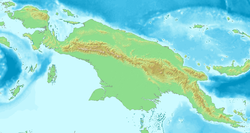| Sicyopterus calliochromus | |
|---|---|
| Scientific classification | |
| Kingdom: | Animalia |
| Phylum: | Chordata |
| Class: | Actinopterygii |
| Order: | Gobiiformes |
| Family: | Oxudercidae |
| Genus: | Sicyopterus |
| Species: | S. calliochromus |
| Binomial name | |
| Sicyopterus calliochromus | |
| Sicyopterus calliochromus is only known from Tirawiwa River in Western New Guinea (Indonesia) | |
Sicyopterus calliochromus is a species of goby in the family Oxudercidae, [3] or alternatively, Gobiidae. [1] [4] It is only known from the waters of the Tirawiwa River, [1] which is a major tributary of the Wapoga River, which in turn flows into the eastern edge of Cenderawasih Bay, in the Papua Province in Indonesia. [2]

